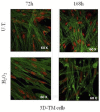A 3D Model of Human Trabecular Meshwork for the Research Study of Glaucoma
- PMID: 33335510
- PMCID: PMC7736413
- DOI: 10.3389/fneur.2020.591776
A 3D Model of Human Trabecular Meshwork for the Research Study of Glaucoma
Abstract
Glaucoma is a multifactorial syndrome in which the development of pro-apoptotic signals are the causes for retinal ganglion cell (RGC) loss. Most of the research progress in the glaucoma field have been based on experimentally inducible glaucoma animal models, which provided results about RGC loss after either the crash of the optic nerve or IOP elevation. In addition, there are genetically modified mouse models (DBA/2J), which make the study of hereditary forms of glaucoma possible. However, these approaches have not been able to identify all the molecular mechanisms characterizing glaucoma, possibly due to the disadvantages and limits related to the use of animals. In fact, the results obtained with small animals (i.e., rodents), which are the most commonly used, are often not aligned with human conditions due to their low degree of similarity with the human eye anatomy. Although the results obtained from non-human primates are in line with human conditions, they are little used for the study of glaucoma and its outcomes at cellular level due to their costs and their poor ease of handling. In this regard, according to at least two of the 3Rs principles, there is a need for reliable human-based in vitro models to better clarify the mechanisms involved in disease progression, and possibly to broaden the scope of the results so far obtained with animal models. The proper selection of an in vitro model with a "closer to in vivo" microenvironment and structure, for instance, allows for the identification of the biomarkers involved in the early stages of glaucoma and contributes to the development of new therapeutic approaches. This review summarizes the most recent findings in the glaucoma field through the use of human two- and three-dimensional cultures. In particular, it focuses on the role of the scaffold and the use of bioreactors in preserving the physiological relevance of in vivo conditions of the human trabecular meshwork cells in three-dimensional cultures. Moreover, data from these studies also highlight the pivotal role of oxidative stress in promoting the production of trabecular meshwork-derived pro-apoptotic signals, which are one of the first marks of trabecular meshwork damage. The resulting loss of barrier function, increase of intraocular pressure, as well the promotion of neuroinflammation and neurodegeneration are listed as the main features of glaucoma. Therefore, a better understanding of the first molecular events, which trigger the glaucoma cascade, allows the identification of new targets for an early neuroprotective therapeutic approach.
Keywords: aqueous humor proteome; endothelial dysfunction; extracellular matrix; glaucoma pathogenesis; trabecular meshwork.
Copyright © 2020 Tirendi, Saccà, Vernazza, Traverso, Bassi and Izzotti.
Conflict of interest statement
The authors declare that the research was conducted in the absence of any commercial or financial relationships that could be construed as a potential conflict of interest.
Figures


Similar articles
-
Molecular changes in glaucomatous trabecular meshwork. Correlations with retinal ganglion cell death and novel strategies for neuroprotection.Prog Brain Res. 2020;256(1):151-188. doi: 10.1016/bs.pbr.2020.06.003. Epub 2020 Jul 1. Prog Brain Res. 2020. PMID: 32958211 Review.
-
The dark phase intraocular pressure elevation and retinal ganglion cell degeneration in a rat model of experimental glaucoma.Exp Eye Res. 2013 Jul;112:21-8. doi: 10.1016/j.exer.2013.04.008. Epub 2013 Apr 18. Exp Eye Res. 2013. PMID: 23603611 Free PMC article.
-
The trabecular meshwork: Structure, function and clinical implications. A review of the literature.J Fr Ophtalmol. 2020 Sep;43(7):e217-e230. doi: 10.1016/j.jfo.2020.05.002. Epub 2020 Jun 16. J Fr Ophtalmol. 2020. PMID: 32561029 Review.
-
[Aiming for zero blindness].Nippon Ganka Gakkai Zasshi. 2015 Mar;119(3):168-93; discussion 194. Nippon Ganka Gakkai Zasshi. 2015. PMID: 25854109 Review. Japanese.
-
From DNA damage to functional changes of the trabecular meshwork in aging and glaucoma.Ageing Res Rev. 2016 Aug;29:26-41. doi: 10.1016/j.arr.2016.05.012. Epub 2016 May 27. Ageing Res Rev. 2016. PMID: 27242026 Review.
Cited by
-
Risk factors for self-reports of diagnosed cataracts among older adults in Poland.BMC Public Health. 2025 Mar 17;25(1):1033. doi: 10.1186/s12889-025-21713-8. BMC Public Health. 2025. PMID: 40098167 Free PMC article.
-
Technological advances in ocular trabecular meshwork in vitro models for glaucoma research.Biotechnol Bioeng. 2022 Oct;119(10):2698-2714. doi: 10.1002/bit.28182. Epub 2022 Jul 25. Biotechnol Bioeng. 2022. PMID: 35836364 Free PMC article. Review.
-
Nanofibrous PCL-Based Human Trabecular Meshwork for Aqueous Humor Outflow Studies.ACS Biomater Sci Eng. 2023 Nov 13;9(11):6333-6344. doi: 10.1021/acsbiomaterials.3c01071. Epub 2023 Sep 19. ACS Biomater Sci Eng. 2023. PMID: 37725561 Free PMC article.
-
iPSCs-Based Therapy for Trabecular Meshwork.Handb Exp Pharmacol. 2023;281:277-300. doi: 10.1007/164_2023_671. Handb Exp Pharmacol. 2023. PMID: 37495850
-
Human ocular fluid outflow on-chip reveals trabecular meshwork-mediated Schlemm's canal endothelial dysfunction in steroid-induced glaucoma.Nat Cardiovasc Res. 2025 Aug 27. doi: 10.1038/s44161-025-00704-3. Online ahead of print. Nat Cardiovasc Res. 2025. PMID: 40866626
References
Publication types
LinkOut - more resources
Full Text Sources

